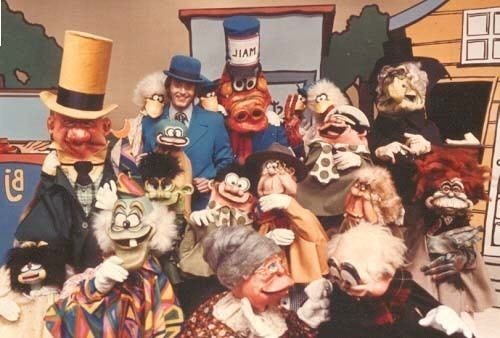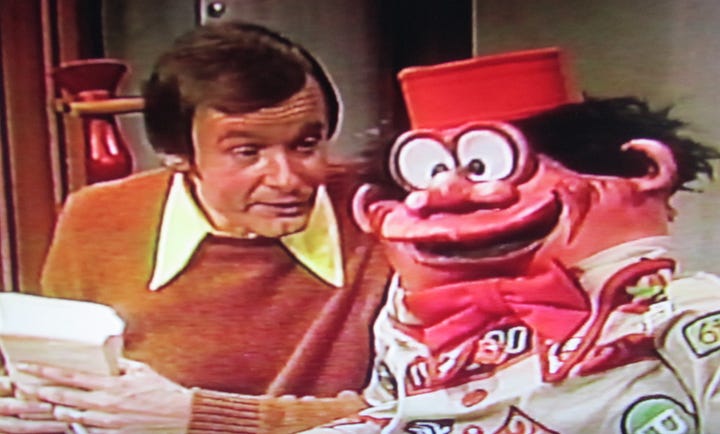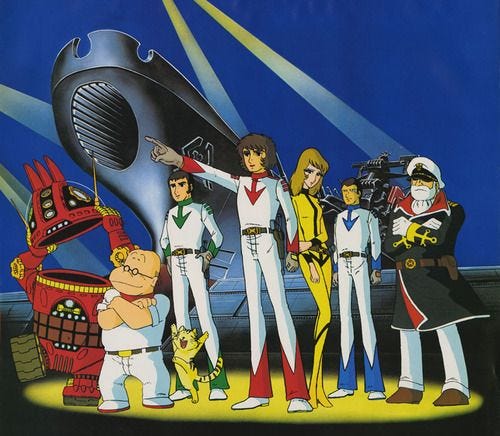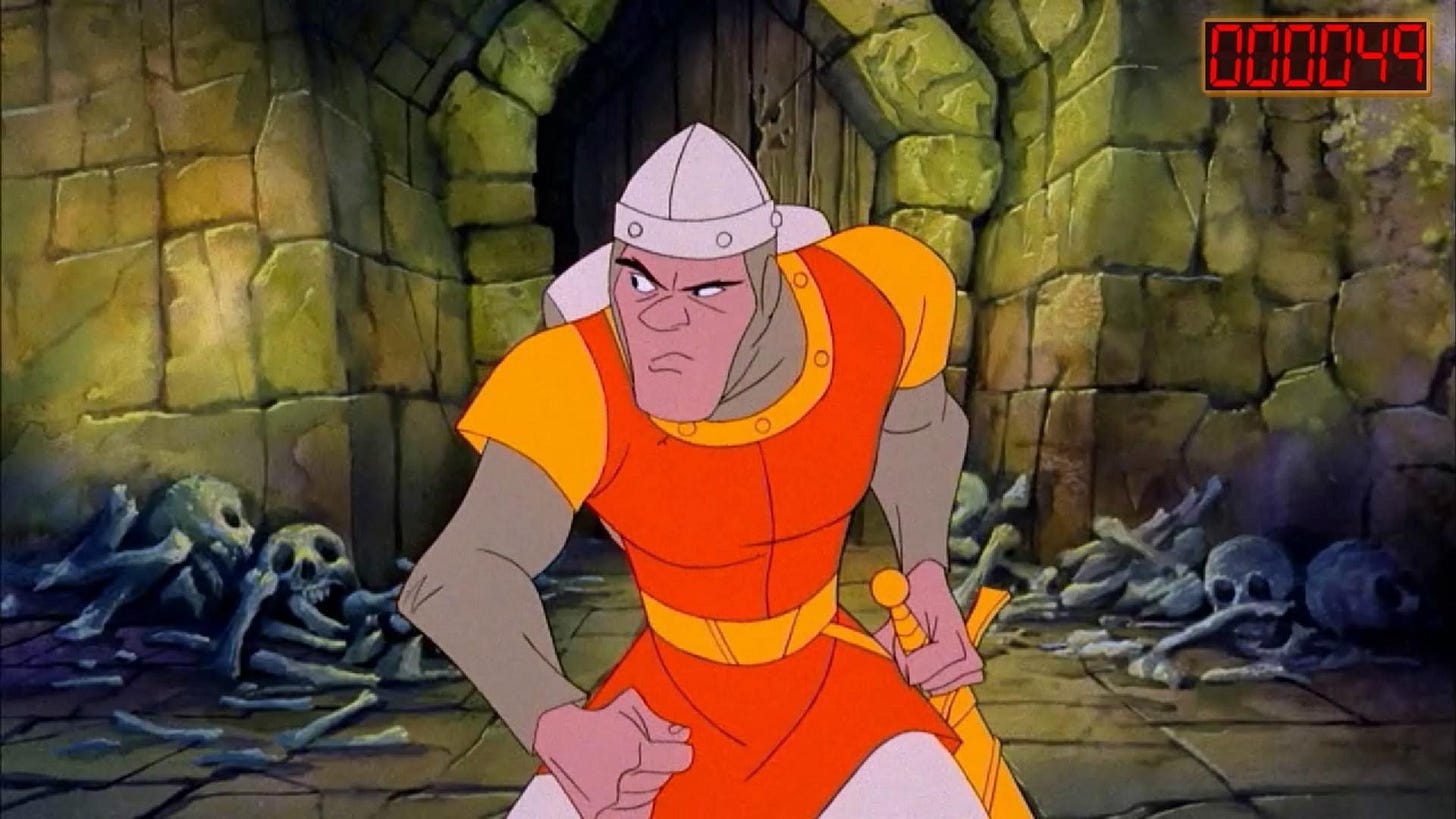Welcome to this edition of This Nostalgic Life. Today we’re talking about creepy, human-sized puppets, anime, and one of the coolest (and hardest) video games ever created. Are you ready? Let’s get going!
More Childhood TV Memories
by Eric Vardeman
Today, I want to specifically talk about the years 1977 - 1980 when I was between the ages seven and ten. There are three television shows that are burned into my brain from that time period that, to this day, I remember and think about like they are my Roman empire. Let’s talk about them.
The Gigglesnort Hotel


In hindsight, this is probably the weirdest thing I watched as a child. A show full of nearly human-sized puppets that just LOOK creepy and grotesque. Bill Jackson was the lone human in the cast that included: Old Man Gigglesnort who owned the building, lived in the attic and thought the hotel was a ship; a dragon that lived in the boiler room, would hurl insults at everyone, and once dressed up as a KKK Grand Dragon; and a blob of clay name, appropriately, “Blob” that couldn’t speak but mumbled and moaned and laughed. The rest of the various puppets were tenants in the building. I watched it every time I found it on TV which was usually by mere happenstance. I remember being fascinated with the hotel itself and its basement, attic and hidden passage ways. All the scenes were dimly lit and, looking back, had a slight undertone of horror at times. As an adult, I’ve watched clips of the show on YouTube and realize this show is way more disturbing than I remembered.
Star Blazers


Between the years of ‘77 - ‘80, I lived in the small, southern Oklahoma town of Duncan. Sitting just 50 miles north of the Oklahoma/Texas border, our major network television stations came from both Oklahoma City and the DFW Metroplex. We also had a non-network station that came out of Wichita Falls, Texas, that mostly played reruns and game shows. Wichita Falls must have been a hot bed of anime activity because that station showed the next two shows that I’ll be talking about with great regularity. Set far in the future, Star Blazers is about a star ship that makes a dangerous voyage to the distant planet Iscandar and back to save Earth from an alien invasion. This show fascinated me because it took a sunken WWII battle ship and transformed it into a star ship that’s fitted with a wave motion engine allowing it to travel at 150,000 times the speed of light. I was already hooked on Star Wars so anything set in space was going to be right up my alley. I’ve actually watched this again as an adult (as much as I could find online) and it honestly still holds up.
Battle of The Planets


This show was on the same station as Star Blazers and honestly was my absolute favorite. It was about five young people, known as G-Force, that protected Earth from the planet Spectra and other attacks from space. My favorite part of the show was their ship, The Phoenix, which transported four smaller vehicles, each operated by one of the team members. I also loved their operational base, Center Neptune, which was located deep in the ocean. During the time I was watching this (and Star Blazers) I was into drawing. Really into drawing, actually. I had notebooks and pads full of drawings, I even got in trouble at school on a regular basis for drawing when I should have been working. Most of my drawings were influenced by this show and Star Blazers (with a liberal amount of Star Wars thrown in). A number of years ago, there were rumors that there was a live action version of this in development. I’ve long since given up on that possibility.
Dragon’s Lair Arcade Game
For those who weren’t there, try to imagine the shock of seeing this game back in 1983. Games like Crystal Castles and Mario Bros. had pretty cool graphics, but Dragon’s Lair was an honest-to-goodness cartoon, hand-designed by The Secret of NIMH director Don Bluth (later responsible for An American Tail and The Land Before Time, among others). There was no ignoring it—Dragon’s Lair practically blew away everything else in the arcade.
In fairness to Crystal Castles and Mario Bros., Dragon’s Lair wasn’t as fully interactive as its video game contemporaries. The game was made possible through the use of Laserdisc technology, whereby Bluth and company were able to animate several scenarios for each scene, essentially making a full-motion Choose Your Own Adventure story. If the correct choices were made, the hero lived on to face the next challenge. If not, the animation skipped to a brief, grotesque, often hilarious death scene.
The game starred Dirk the Daring, a heroic but not always bright knight in shining armor. The voluptuous Princess Daphne had been kidnapped by the dragon Singe, and Dirk stormed the beast’s lair to get her back. From the entrance on, there was no set pattern for your individual adventure. Scenes were accessed randomly, though they were grouped in increasing levels of difficulty.
Within 22 minutes of animation, Dirk faced such nightmares as snakes, spiders, vampire bats, giant spinning batons, electrified fences and floors, dangerous potions, a flying metal horse, the purple Giddy Goons, the enchanted Smithee, the Lizard King, the Crypt Creeps, Mud Men, the Black Knight (on more than one occasion) and finally Singe himself. To further throw off players, the rooms were often reversed, so memorized patterns weren’t always foolproof. With so much full-motion animation and so many split-second decisions to make, Dragon’s Lair made players feel like they were part of an interactive movie, and they loved it.
Six years and 1.3 million dollars in the making, Dragon’s Lair was the result of a collaboration involving Bluth, game designer Rick Dyer and Space Wars creators Cinematronics. The latter was in dire financial straits by the time the game was released in 1983, but Dragon’s Lair was an instant hit, pulling in quarters by the millions and drawing the attention of national news organizations. Dragon’s Lair got its own Saturday morning cartoon, as well as a large line of tie-in merchandise. Laserdisc games entered a mini-boom, spawning titles like Firefox, M.A.C.H. 3, and the Bluth/Dyer/Cinematronics follow-up, Space Ace.
The high times were short-lived, however. The fledgling technology was notoriously temperamental, causing several breakdowns and not a few headaches for arcade owners. Furthermore, once the game was over, there were no harder levels to beat. “Cheat sheets” hit the video game grapevine, and soon even novice Dragon’s Lair players knew how to beat the machine. The Laserdisc phenomenon died out as quickly as it had been born, leaving only one true superstar: Dragon’s Lair.
The creators had been working on a sequel since 1983, but the end of the boom put production on hold. In 1991, Dragon’s Lair II: Timewarp was finally released by the Leland Corporation. In the new adventure, Dirk and Daphne were married with children (several), but the evil wizard Mordrec appeared and kidnapped the lovely princess. After escaping his wife’s battleaxe mother, Dirk set out to find the wizard. Using a broken-down time machine, Dirk chased Mordrec through real and fantasy history, battling Alice in Wonderland villains, Beethoven’s cat, Egyptian mummies and even Daphne herself, transformed into an enormous purple beast.
The sequel didn’t make as much of a splash as the original, but it kept the legend alive for die-hard Dragon’s Lair enthusiasts. Faithful home computer versions of the original appeared in the early 1990’s, continuing to win new players throughout the decade. Fans’ patience and enthusiasm were finally rewarded in May of 1999 with the announcement of a new installment, Dragon’s Lair 3-D, due in PC and Macintosh formats in the not-too-distant future.
By Eric Vardeman
In 1984: Peaking this week at #6 is one of my favorite songs from the entire decade, “I Can Dream About You” by Dan Hartman. Written by Hartman for the soundtrack to “Streets of Fire” (a criminally underrated and under appreciated 80’s flop of a movie), it was originally recorded and performed in the movie by Winston Ford. However, through some legal and contractual maneuvering, Hartman was able to enforce some contractual obligations that allow him to re-record the song himself and stipulate that any video for the song had to feature his version. On of my favorite songs to this day.
In 1990: Peaking this week at #35 is “We’re All In The Same Gang” from the West Coast Rap All-Stars. Produced by Dr. Dre, it’s a hip-hop song by a collaboration of prominent American West Coast hip-hop recording artists who assembled to promote an anti-violence message. The lineup on this song is ridiculous and it’s criminal that it didn’t climb higher up the chart. You can find the whole story about this song here.
Playlist: This Week In 1984
Playlist: This Week In 1990
In every edition of This Nostalgic Life, we like to share a curated list of nostalgia-themed articles, stories, and posts that we’ve come across recently. It gives you a chance to discover great content and remember things from your past that you may have forgotten. With that in mind, here are some things we wanted to share with you this week. (All links will open in a new tab.)
Why There’s Nothing Better Than An Old-Fashioned Roadside Store (Southern Living)
The Best Retro Games From the 1980s (The Gamer)
The Myth Behind the Invention of Kellogg’s Cereal (Chowhound)
Bigfoot vs. USA-1: The Birth of Monster Truck Madness (History)
The History of Tab and Why It Was Discontinued (The Daily Meal)
The ‘80s Toy That Was Considered a Threat to National Security (Mental Floss)
That’s going to do it for this issue. If anything stirred any memories for you, let us know by leaving a comment!












Omg I forgot about this!
Have great memories of Battle of the Planets